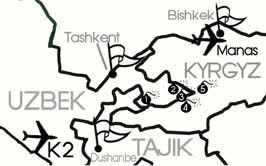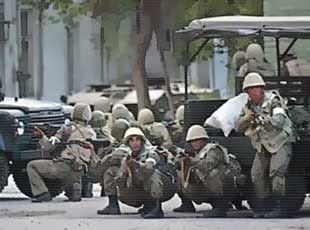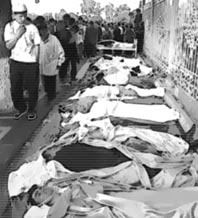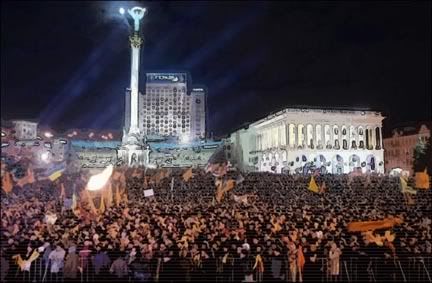Adam Larson
Caustic Logic / Guerillas Without Guns
2/20/07
“Without warning, the soldiers opened fire into the crowd. Bodies fell like mown hay, row upon row.” - Galima Bukharbaeva, eyewitness to the massacre at Andijan, May 13 2005
 |
In the early months of 2005, a peaceful protest began outside a city courthouse in the eastern Uzbek city of Andijan, not far from Tashkent but nearer to restive Kokand and the Kyrgyz city of Osh just across the border, where the “Tulip” mutiny would soon go down. This was the heart of the rebellious Ferghana Valley, where development has lacked in a densely populated and heavily Muslim area - Uzbekistan’s Kosovo. The gathered protesters were demanding the release of 23 local businessmen who had been arrested and charged, wrongly their supporters said, with supporting the local Akramiya movement, a designated terrorist group. This was problem number one in the episode’s reporting in the West – Karimov calls everyone he dislikes a terrorist, so few believed the charges. The protest thus seemed to have a strong basis as day after day it assumed the scale of an extended, mostly peaceful, vigil.
The headcount before the courthouse grew as spring brought better weather. But late on the evening of Thursday, May 12, some of the protesters were arrested and taken to the town's jail, and the stage was set for a bizarre and tragic chain of events. I’ve drawn primarily on BBC News reports, which have their shortcomings on specifics of the incident (a point to which we’ll return). A mysterious band of armed men stormed the jail just hours later, in the pre-dawn hours of Friday the 13th, and freed the 23 accused men, their supporters and “scores” of other inmates. The militants also raided an armory or two and seized a larger cache of guns. BBC’s reports make little note of the curious fact that the police station, military unit and jail that were attacked that morning are clustered into a 1-2 km radius of each other. Worse, Pravda later noted, “for unknown reasons” this obviously dangerous complex is located just on Andijan’s outskirts, not far from downtown. Pravda noted “in 13 years of Uzbekistan's independence the town administration has not hit upon the idea of transferring the jail to a new adequate place.”
An uncertain number of these mysterious men, now heavily armed, then marched north from the prison with the rising sun about 4 km to the site of the protests in downtown Andijan. The raiding party appeared on the streets as the day’s rally began, and some of the militants reportedly took a role in organizing the protests. But most of the thousands of demonstrators in the main Square “are ordinary people,” the BBC stressed, “and the atmosphere is calm.” The crowd swelled to about 10,000 by early afternoon, with the ordinary things - speakers vented anger at repression, economic problems, and trade restrictions. Protesters joined in chanting slogans against Karimov and the Uzbek government, as in any normal rally.
But this was not normal in Uzbekistan; these peaceful petitioners had been provided a special environment on that day. Someone, between the militants and the protesters, had blocked all the roads to the city center with buses and debris, and somehow by this time were in control the area, “including government offices.” No countervailing security forces seemed to be anywhere, aside from the ten police officers the gunmen were holding hostage. The rest had apparently fled or been killed, and so the “protesters” were thus given temporary de facto right of assembly; score one for freedom. But as the warm day wore on, rumors circulated about government troops and tanks amassed out at the airport.
When such events had happened in Kyrgyzstan just weeks earlier, President Akayev had said the mutiny was designed to provoke a violent crackdown, a bait he would not take. In the end, he lost control and fled to Russia. Now that cities were being taken over just across the border on Uzbek soil, it would become apparent that Karimov had a different philosophy on the issue. Security forces reportedly were given orders to “eliminate” the single group they said was behind both the storming of the prison and seizure of government buildings.
 |
 |
An evident logical disconnect here is why children, and women if they’re thought of as off-limits innocents, were brought along to this militant event. Bukharbaeva explained this simply: “parents brought their children to see the unprecedented spectacle,” and failed to take the kids back home because while “the rebels expected that the army would move against them,” the peaceful crowd “had no inkling of its fate.” Sure they were being led by convicted terrorists, the West seems to be saying, but they were probably wrongly convicted, after all. And sure, they had just been broken out of prison and heavily armed, chased the cops away and took some hostage, took over the city’s seat of government, and blocked the roads into downtown. But otherwise it was a peaceful protest by non-terrorist people who were simply fed up and wanted change. This is the perfect thing to bring your children to – not just as human shields but as spectators of a brave new future opening up – at least until the authorities stepped in with their unprovoked and unexpected slaughter.
In the official version, president Karimov placed blame for the unrest solely on Islamic extremist groups whose aims of “hatred and denial of the secular way of development […] are unacceptable for us.” Government estimates of the casualties were 187 people killed, including 94 terrorists. He explained that Uzbekistan’s territorial integrity was at stake; “they are brainwashing young people with ideas of creating a unified Islamic state.” He said his troops were forced to shoot the terrorist “demonstrators” as they tried to break through police lines (which by the BBC account didn’t exist – an advancing column is not a police line). Karimov insisted any deaths of innocents were at the hands of the “terrorists.” After all, as Karimov asked his accusers, “how could I give the order to shoot at my beloved people?”
29 men were declared wanted, but 12 of those had already fled to neighboring Kyrgyzstan and, the government says, offered refuge by the new government there. RFE/RL noted the “strained relations” following Bakiyev’s July decision to allow over 400 Uzbek refugees to be airlifted from Kyrgyzstan to Romania. But 15 of the remaining 17 were caught and put on trial in October, charged with terrorism, shooting hostages and belonging to banned Islamic groups. All pled “fully guilty” at first opportunity. The instant confessions naturally raised concerns of coercion and possibly torture. The UN commission on human rights protested that there were “serious inadequacies” in the conduct of the trial: the ill-defined nature of “terrorism,” no independent cross-examination of the defendants, a lack of physical evidence, and the fact that “all but one eyewitness account at the trial mimicked the government’s version.” All were convicted and sentenced to terms from 14 to 20 years.
The government’s case continued well beyond the initial wanted list and into multiple trials; by the end of the year 151 people had been convicted in connection with the events at Andijan, including 19 soldiers and five policemen found guilty on December 23 for “negligence and dereliction of duty.” All but one of the series of trials were held behind closed doors, to protect state secrets that may arise in the testimony and to protect the defendants and witnesses, the Supreme Court said. [25] The West took this secrecy as a sign of official guilt and dismissed the trials as a farce of justice.
Karimov’s government has gone past exculpating itself for Andijan to blaming Washington. The government brought attention to the testimony of one defendant at the Andijan trials that the U.S. embassy in Tashkent had a role in organizing the violence. Daniel Fried at the State Department strenuously denied this charge. “These allegations are ludicrous. The assertions that the U.S. supports an attack by Islamic extremists after fighting four years against exactly such people is not credible,” he said. Finally we see a western admission that Karimov had been fighting terrorism – not just his citizens - at Andijan. The Islamist-terrorist-separatist charge against the Andijan suspects, while politically motivated and almost certainly a distortion of the truth, is still a more solid a label for what happened than any proposed in the West. Karimov’s charges of Islamist separatism have routinely been met with the non-answer that innocents were killed at Andijan because, it seems, the Western media has no actual answer to the charge.
An early BBC report from the 13th – after the seizure of the town but before the government attack - explained that “at this stage the identity of the gunmen who stormed the prison is not known, and it is not clear what, if any, connection they have to the people organising the demonstration.” A search of over a dozen BBC News stories on the subject from the following months reveals no further clues, and one year on, Ian McWilliams wrote for them “who organised the prison breakout and whether they had outside help is still unclear.” The reason for the lack of clarity is not poor journalism or official censorship but rather the fact that “the Uzbek government has repeatedly refused to allow an independent investigation.” And in the absence of absolute “independent” clarity, they haven’t bothered to even clue us in on any leads or possibilities.
But to imply a total media blackout is disingenuous. Back on July 13, the two-month anniversary of the tragedy, a group of twenty foreign diplomats and journalists from eight countries including Russia, India, and China were invited by the Government of Uzbekistan to wander freely around Andijan for a single, pre-selected afternoon and investigate for the truth themselves. The BBC chose to sit out this Tashkent-managed petting zoo, but Russia’s Pravda paper sent a correspondent, Aloke Shekhar, who offered the following day “a truthful report of this trip without any hint at politics.” Unlike the BBC, which bemoaned the lack of an “independent” inquiry, Pravda’s reporter assured his readers “the truth cannot be hidden under cover. Sooner or later we will learn the truth about these tragic events.”
By this article’s account, which squares perfectly with the Karimov-Putin line, the militants are still described as “unidentified persons” but believed to be organized by “Islamic movement of Turkestan, Hizb-ut-Tahrir and Akramists,” some of them identified as foreigners. In the pre-dawn hours a group of 50-60 attacked an Interior Ministry post and military unit No. 45605, seizing a total of 334 weapons to add to their own arsenal. Then they attacked the local jail, rushing in with guns blazing, and freed 737 prisoners, ordering them to “run away otherwise you will be killed.” One freed prisoner – presumably back behind bars - told Shekhar that the militants “wanted to once again stage the Kyrgyz scenario. It was obvious that they were acting in line with a well prepared plan.”
Most convincing to Shekhar was the video shown by the Uzbek authorities that “froze the hearts of everyone.” It was allegedly shot by the terrorists themselves in real-time as they carried out their “protest” activities. We are told the video shows the beating of policemen by the mob, the burning of buildings, the manufacture of explosives, and scenes of men firing the seized weapons and shouting “Allahu Akbar!” Shekhar summed up “without any hint at politics:” “Only authorities know when the film will be presented to the public. But one thing is clear: this film is a heavy slap to the West. […] It is high time the West descended from the heavens and faces the truth.”
Instead, on October 26 BBC News reported it was pulling out of Uzbekistan entirely “due to security concerns.” The Tashkent office was to close for at least six months “pending a decision on its long term future.” The regional director said “over the past four months since the unrest in Andijan, BBC staff in Uzbekistan have been subjected to a campaign of harassment and intimidation which has made it very difficult for them to report on events in the country.” So they allowed themselves to be “intimidated,” and official statements notwithstanding, the exact cause–and-effect relationship between this harassment and the BBC’s incomplete reporting is just as unclear as the public’s picture of what actually happened at Andijan.
Sources:
- Weinstein, Dr. Michael A. ''Intelligence Brief: Uzbekistan'' Power and Interest News Report. June 23, 2005. http://www.pinr.com/report.php?ac=view_report&report_id=318&language_id=1
- How the Andijan killings unfolded. BBC News. May 17 2005. http://news.bbc.co.uk/1/hi/world/asia-pacific/4550845.stm
- “Andijan - two months later: A truthful report from Uzbekistan's Andijan” Pravda. Front page / World. July 14 2005. http://english.pravda.ru/world/20/92/373/15802_andijan.html
- Norton, Jenny. “What lies behind Uzbek protests?” BBC News. May 13 2005. http://news.bbc.co.uk/1/hi/world/asia-pacific/4543847.stm
- Bukharbaeva, Galima. “Witness to a Massacre. An Uzbek reporter risked her life to tell the world of Andijan assault.” Dangerous Assignments/ Committee to Protect Journalists. Posted October 25, 2005 at:
http://www.cpj.org/Briefings/2005/DA_fall05/galima/galima_DA_fall05.html
- Gandelman, Joe. “Uzbekistan Political Turmoil Worsens As Putin Backs Government.” The Moderate Voice. May 15 2005
http://www.themoderatevoice.com/posts/1116134918.shtml
- Kimmage, Daniel. “Central Asia: Holding On To Power .“ Radio Free Europe/Radio Liberty. November 14 2005
http://www.rferl.org/featuresarticle/2005/11/44D3EF33-3F8F-4E0A-806E-520F146DBA93.html
- “Jail demand for Andijan suspects.” BBC News. October 26 2005. http://news.bbc.co.uk/1/hi/world/asia-pacific/4378816.stm
- Saidazimove, Gulnoza. "Uzbekistan: Authorities Reject UN Accusations Over Andijon Trials." Radio Free Europe/Radio Liberty. December 27 2005. http://www.rferl.org/featuresarticle/2005/12/e94929a5-af45-4e0d-8b00-29097fd28820.html
- "U.S. Promises to Leave Airbase in Uzbekistan." Mosnews. September 28 2005. http://www.mosnews.com/news/2005/09/28/ustoleave.shtml
- MacWilliam, Ian. "Outlook bleak in wake of Andijan." BBC News.May 11 2006. http://news.bbc.co.uk/1/hi/world/asia-pacific/4761821.stm
- "'Harassed' BBC shuts Uzbek office." BBC News. October 26 2005. http://news.bbc.co.uk/1/hi/world/asia-pacific/4380166.stm


No comments:
Post a Comment